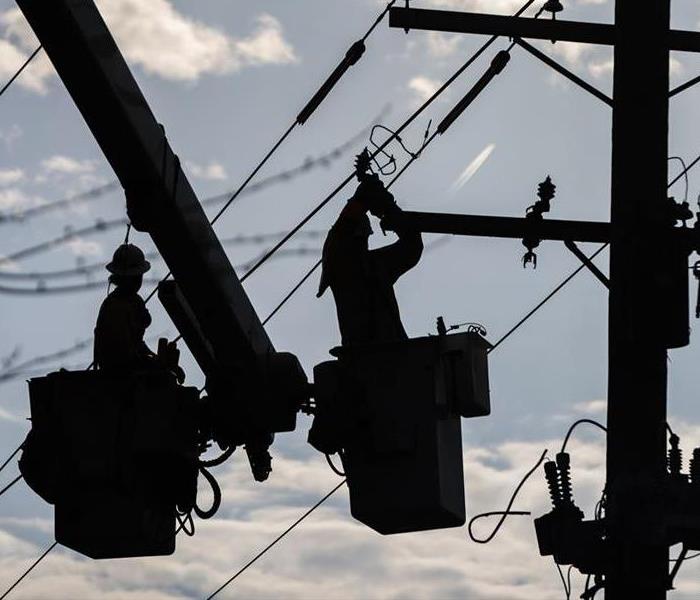Recent Storm Damage Posts
Things To Do Before Help Arrives
11/30/2021 (Permalink)
If your home or business has water damage, you can do some things before help arrives.
Make sure that the building or home is safe.
SERVPRO of Lincoln Wants You to Remember:
- Waterlogged materials are very heavy
- Wet surfaces are slippery
- Make sure electrical power is off before you handle devices
- Make sure you are standing on dry area before you turn on the electric power
SERVPRO of Lincoln suggests that you:
- Remove excess water with mops and/or towels
- Wipe water from wood furniture or other items
- Remove wet cushions. Prop them upright to dry
- Hang up rugs to dry
- Place foil or blocks between furniture and wet carpeting
- Turn on dehumidifiers or air-conditioning if it is safe
- Move colored items from wet carpeting
- Move artwork to a safe, dry place
- Move loose items from the floor or counters
- Start drying items ASAP
- Remember that mold starts growing within 24 hours
- Stay away from rooms that have sagging ceilings.
How To Prepare Your Home For A Storm
8/13/2021 (Permalink)
Quick guide to preparing for a storm
- Ensure your drains and gutters are clear of debris to prevent blockages.
- If safe to do so, check your pipes and water tanks are insulated to prevent freezing and that the release point of overflow pipes is not obstructed. Ideally, you'll have a regular maintenance program in place.
- Cut back trees and branches to minimize the risk of falling branches.
- Secure loose fences.
- Check that roof tiles and aerials are secure if you can do this safely. It may be worth seeking professional advice.
- Make sure garden furniture and ladders are secured in case of high winds or locked away in the shed or even inside your house.
- When you know a bad storm is on its way with warnings about gale-force winds and floods, make sure children, pets and your family and neighbors are safe. Make sure you're indoors when it hits and don’t try and repair damage during a storm.
Always be cautious when undertaking any task that you're not fully familiar with as you could injure yourself or those around you, seek professional help where required.
So make sure you're storm ready. Secure loose objects such as ladders and garden furniture. Close and secure all windows and doors. Check on loved ones before a storm strikes, but once it arrives, stay indoors. Do not try to drive or move around outside near trees or buildings that could collapse.
If you experience storm damage give us a call at (708)483-8636.
Keeping Your Home Safe from Storm Damage
7/23/2021 (Permalink)
Storms can come upon us without much warning. Yes, we watch the news, but bad weather is still unpredictable, so we need to take steps to keep our homes safe from storm damage.
An inspection of your home’s premises is a really good idea to conduct before inclement weather hits. A leaky roof or windows can cause big problems during extreme conditions such as a snow storm or heavy rains. Do all your exterior doors and windows fit correctly? When’s the last time you took a look at your roof to see how things are looking up there? These are all great questions to ask yourself.
Loose shutters and rain gutters can present a real problem in high winds, as can unstable large trees. It might be a good idea to trim back trees and bushes with large heavy branches that are not in good condition, so that windows and vehicles are not in danger of storm damage in windy conditions.
Many homes in older cities have drainage ditches at the front of the property. Take time to inspect this area and remove debris or dirt that might obstruct the flow of water from a heavy rain. A clogged drainage ditch can cause a lot of damage by flooding your property during, or even after, a storm.
Your family is very precious to you. In the event of a storm, do you have a system in place that will help you to get information to everyone in case of a weather emergency? Most of us use our cell phones to communicate these days, but in the case of a bad storm, your cell phone service could be at risk. You might consider installing a good old-fashioned landline, just in case. If you or a family member gets stuck at work or out doing errands, families will worry, so it’s vital that lines of communication stay open.
SERVPRO of Oak Park-River Forest specializes in the cleanup and restoration of residential and commercial property after a fire, smoke or water damage event. We can handle any size disaster!
Call us at (708) 483-8636!
Flood Damage and Pack-out Procedures
7/19/2021 (Permalink)
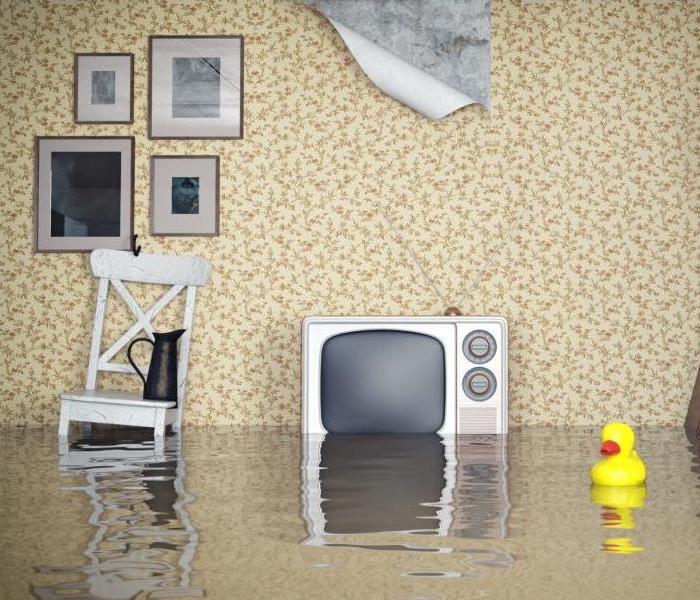
Sustained rainfall can result in groundwater flooding of your property. Not only do high standing water levels exert significant pressure on your walls and flooring, but they can also carry high levels of contamination. As a homeowner, you may be able to deal with clean water emergencies yourself. However, floodwaters carry with them infectious waste, which can be harmful to your health.
You need professional assistance from trained technicians to overcome flood damage to your home. At SERVPRO, we run a unique out-of-hours emergency service for victims of groundwater, flash flooding, or storm-related events. We will ensure that your property and contents sustain as little harm as possible. We strive to reduce the expense of your claim by using our advanced equipment and professional expertise to repair the damages quickly.
In severe flooding scenarios, it may be necessary to store your contents at the separate facilities while work is undertaken. Separate storage can frequently mitigate against further losses while we work to restore the structure itself. When a pack-out service is necessary, SERVPRO technicians take an inventory of your possessions, their condition, and the rooms to which they belong. This ensures you are covered in the unlikely event of transit damages.
One advantage of a pack-out procedure is that it can significantly reduce the timeframe of your property restoration. Less furniture provides greater access to all areas of your home's structure. This access can be helpful should we need to perform structural or cavity drying as well as demolition of non-salvageable materials. Once your property has been returned to a sanitary condition, we can use our automated inventory to put furniture and possessions back where we found them.
SERVPRO of Oak Park-River Forest specializes in the cleanup and restoration of residential and commercial property after a fire, smoke or water damage event. We can handle any size disaster!
Call us at (708) 483-8636!
What NOT To Do After A Flood
7/12/2021 (Permalink)
During a storm, flood water can invade your home and cause considerable damage to your property. However, your main priority should always be to get yourself, your family members, and your pets to safety. Once the storm has passed, you can return to assess the damage and begin the cleanup process. Here are four things you should not do when returning to the site of a flood.
1. Make Contact With the Water
Floodwater can contain many different types of contaminants including bacteria, viruses, chemicals, and debris. Help protect your skin from harmful water by wearing rubber boots and gloves and keeping your hands and face from making contact with the water. If contact occurs despite your best efforts, wash immediately with soap and clean water.
2. Enter Standing Water
After a flood, homes, yards, streets, and other areas can be covered in standing water. Powerful winds often accompany heavy storms, so it is not uncommon to find downed powerlines after a storm. Since water from a flood is usually murky, you cannot always tell what lies beneath the surface. If the water has been electrically charged, you could experience an electric shock if you enter a flooded home. Rubber boots will help protect against the risk of electrocution.
3. Let the Water Sit
The longer water sits, the more time bacteria have to multiply. When items are left to sit in water for long periods of time, the structural integrity of those items can begin to break down. The water should be safely extracted as soon as possible. By cleaning the water faster, you can help to lessen any water damage to your home. Since mold can begin forming in as little as 24 to 48 hours, it is important to begin the drying process as soon as the water has been extracted.
By following a few precautions, you can help keep yourself safe from the dangers of floodwater.
If you have experienced a flood or any type of water damage, a professional flood restoration company can help get your home back to its pre-flood condition. Give our team a call at (708) 483-8636 for an assessment.
Purpose of Flood Cuts
7/12/2021 (Permalink)
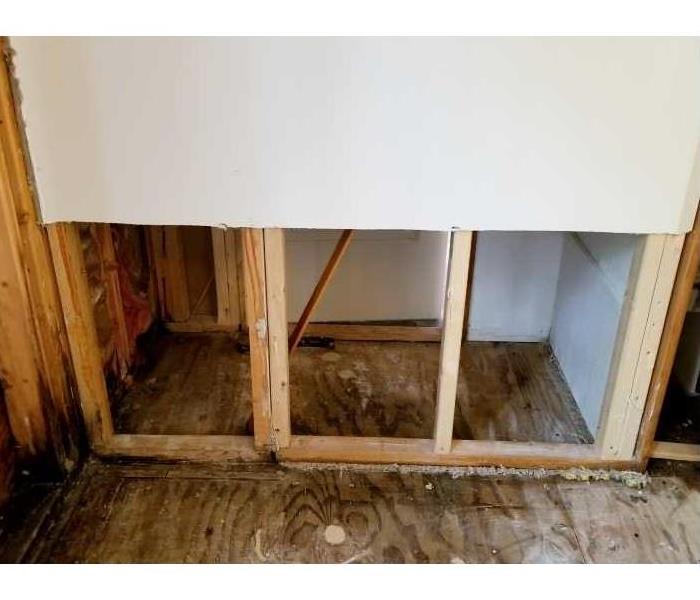 Heavy storms can lead to severe flooding damage.
Heavy storms can lead to severe flooding damage.
A heavy storm can cause a significant amount of damage to your home. Lightning can strike trees, causing them to fall on the house and tear up the roof. High winds that pick up debris can lead to broken windows. The main concern during a storm, however, is likely flooding. If a weather event in the Chicagoland area leaves behind a lot of standing water in your home, flood restoration specialists may have to make a flood cut to remove all the damage.
When Is a Flood Cut Necessary?
A flood cut is the method the cleanup team uses to tear out materials that can't be salvaged. Technicians will probably need to use a flood cut if the water damage meets certain criteria:
- High levels of contamination
- Suspected damage in hard-to-reach areas
- Compromised structural integrity of the wall
Flooding from a storm almost always leads to a flood cut because the water is contaminated. If the standing water in your home comes from a clean sources, however, technicians may try to save the wall, even if there is a lot of water.
How Is a Flood Cut Measured?
When removing drywall, the mitigation team wants to make sure that it tears out all the damage. Specialists typically make a flood cut at least 12 inches above the spot where the water damage ends. This ensures that any unseen damage is also removed.
What Happens After the Flood Cut Is Made?
Once the cut is made, the technicians remove the drywall. They take out all the damaged material, including any damp insulation behind the wall. Before they rebuild, they have to make sure the area is clean and dry so that no secondary damage occurs.
If a storm causes flooding in your home, it may take more than simply removing the water and wiping down surfaces to complete the repairs. Technicians may have to make flood cuts on your walls to remove all the damage.
What are the Two Main Types of Flood Damages?
6/2/2021 (Permalink)
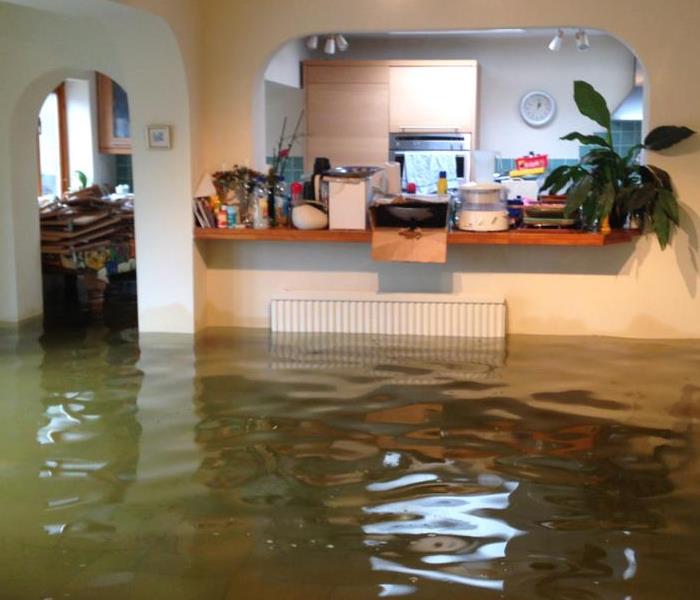 When storms hit, SERVPRO is standing by to restore any damage.
When storms hit, SERVPRO is standing by to restore any damage.
SERVPRO Professionals Handle Any Size Flood Damage in Chicagoland Properties
When heavy storms impact the area, the result can be more water than the city drainage can handle, and flooding may occur. As long as the water is outside the property, there are no significant issues.
If flood damage occurs to a property, two main types of floodwater wind up in a home. The first is clean water from a damaged roof that allows rainwater or snowmelt into the house. As long as this gets extracted and dried within 24 hours, there are little to no health hazards. When groundwater such as from the river enters a home, it can hold a host of contaminants and debris, meaning people and pets in the house should not come into contact with it.
SERVPRO technicians have the equipment to safely handle this type of water damage cleanup, including:
- Personal protective gear
- Professional biocides for water treatment
- Extraction equipment to move large amounts of water quickly
SERVPRO of Oak Park-river Forest at (708) 483-8636 is available any time of the day or night for flood damage cleanup.
Power Outages Can Cause Damage To Your Home or Business
6/2/2021 (Permalink)
A summer thunderstorm can be fun to watch from a safe distance. The warm air, the rolling sound of the thunder in the background and the streaks of lightning that light up the night sky is like natures version of fireworks. But of course, with a thunderstorm, the chance of a power outage is always a possibility.
Normally, a short power outage is no big deal, but the longer the power is out the potential for damage to a home or business increases. For example, homes that take on water during storms generally, have a sub-pump that removes the water from the basement before damage can occur. Without power, this pump will not work allowing water to fill up the basement. Or if you rely on air conditioning to keep your home or business from getting too humid, a power outage can quickly lead to mold growth.
If you do run into any of these issues contact our office. We can help you to repair water damage and remove mold.
The Weather Outside is Frightful
11/23/2020 (Permalink)
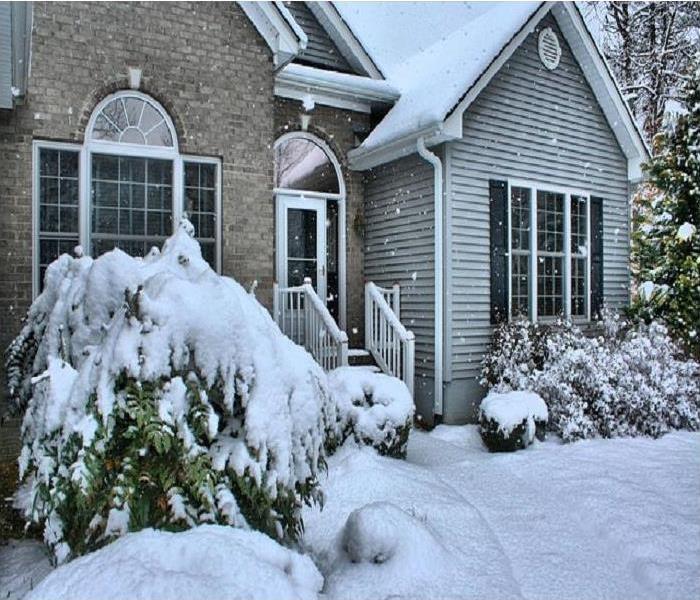 Winter can put your home at risk for damage.
Winter can put your home at risk for damage.
Winter. You either love it or hate. While snow is beautiful and puts us in the holiday spirit, there have been winters in the past where it was a little too extreme. Snow storms are a big reality for us in the Chicagoland area and they have potential to do large amounts of damage, as much as a storm during the warmer months. We at SERVPRO of Oak Park-River Forest would like to share some tips for protecting you and your home according to the American Red Cross.
- Prevent pipes from freezing by opening doors and cabinets where they are to expose them to the houses heat. Letting water run through pipes can also prevent them from freezing.
- Double check that your heat source is clean and in proper working condition.
- Cover windows with a plastic layer to provide an extra layer of insulation to keep heat from escaping out of cracks.
- Consider purchasing an emergency heater and a portable generator in case you lose power.
- Have an emergency kit with food, water, medication, and medical supplies.
We can’t control the weather but if you have water damage from frozen pipes and snow melting or you roof collapsing from snow, call us. We have 24/7 emergency services here to help you.
Storm Power Outage Safety Tips
8/17/2020 (Permalink)
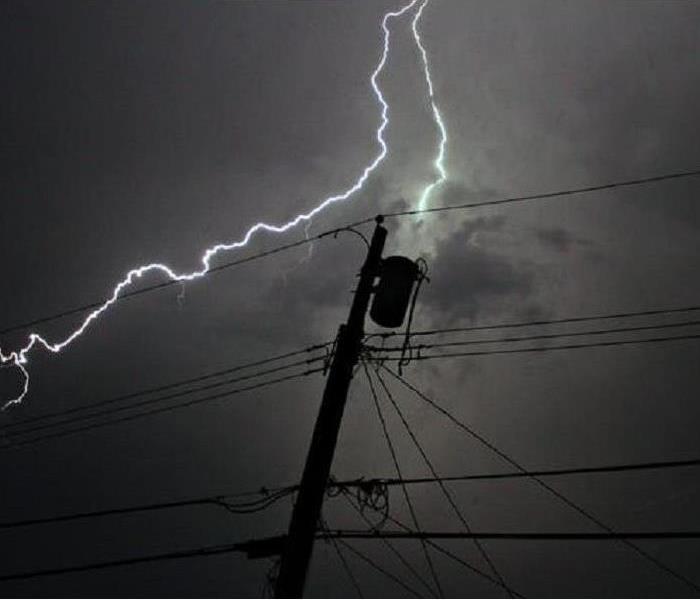 Storms bring more than just water and impact damage.
Storms bring more than just water and impact damage.
In the Chicagoland area we experience our fair share of storms. In early August we had a derecho roll through and it brought thunderstorms, tornadoes, and high-speed winds across the Midwest. Many people had damage to their roofs from tree limbs and other flying debris. Even more people were left without power, some for more than a week after. If you don’t already have a generator, it could be wise to think about getting one. They are a handy tool during storm seasons just in case you lose power. The American Red Cross and SERVPRO of Oak Park-River Forest would like to give you a few safety tips for power outages.
- Never use a generator, grill, camp stove, or other gasoline, propane, natural gas, or charcoal-burning devices inside a home, garage, basement, crawl space, or any partially enclosed area.
- To avoid electrocution, keep the generator dry and do not use it in wet conditions. Operate it on a dry surface under an open canopy-like structure, such as under a tarp held up on poles. Do not touch the generator with wet hands.
- Run the generator every few months to make sure it is still functional.
If you experience water or storm damage, call SERVPRO of Oak Park- River Forest at (708) 483-8636.
Tips for Preparing Your Home for a Storm
7/30/2020 (Permalink)
Some people love to watch storms roll in, while others get nervous for a variety of reasons. You might be thinking about hail hitting your car that is parked outside or what debris the wind is carrying that could damage your house. As much as we wish we could, we cannot control the weather to make it sunny and 75°F every day. Let us give you some tips on how to make your home more prepared for storms to come.
Seal Your Roof
Making sure that your roof is in good condition is an important first step in keeping your home safe from potential storm damage. Roof seams could be sealed with a ‘peel and stick membrane’ or with a polyurethane foam to prevent cracks and leaks. Keeping your roof in good standing now is in investment in your home and the things inside of it.
Secure Your Windows and Doors
High winds put your windows and doors at risk. Doing annual checks for rusty hinges and missing or loose screws can prevent serious damage. Also making sure that your door threshold is in good condition can prevent water from getting into your home through the front door. If you live in places where hurricanes, tornadoes, or other extreme storms can happen, it is wise to invest in impact resistant windows.
Secure Fences
If you live in a home that has fencing, or you are thinking of putting a fence in, it is important to consider how storms may impact them. You need to consider the strength and resilience of the materials and how they are installed. Fences can be struck down by strong winds or debris. Even though the less expensive option for fencing seems like the best choice right now, it might end up costing you more later.
Have an Emergency Plan
Preparation is key when it comes to minimizing loss during a storm. This goes towards your home and your family. Creating a plan with members of your house on how to stay safe can go a long way. Know what the safest place in your home is. Have a kit with batteries, food, and medical supplies. Know important phone numbers. And if you have pets, factor them into this plan as well.
Be Mindful of Loose Objects
After storms, you can usually look out on the street and see trash cans or other miscellaneous objects knocked over on the ground. Anchoring loose objects in your yard such as trampolines, grills, bikes, patio furniture, umbrellas, or inflatable above ground pools will keep them from becoming a risk that could damage your house or your neighbors.
Common Weather Alerts and What They Mean
7/30/2020 (Permalink)
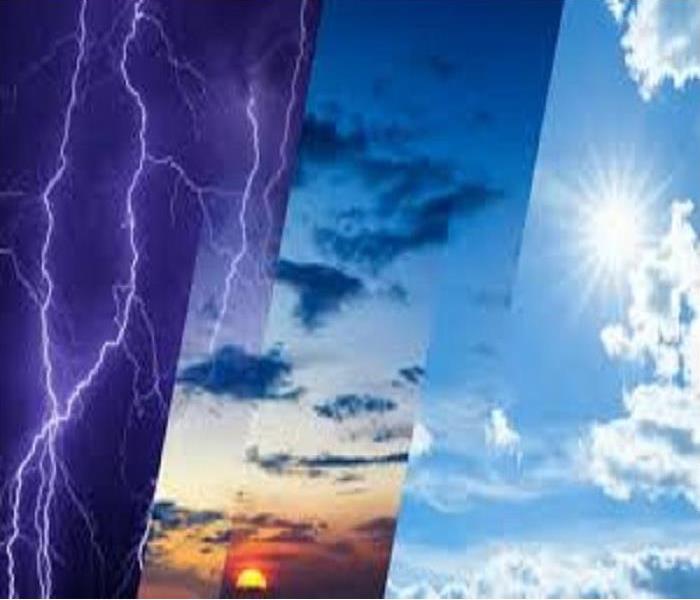 Keeping up with weather forecasts can help you anticipate storms and be ready for any kind of alert.
Keeping up with weather forecasts can help you anticipate storms and be ready for any kind of alert.
Throughout the year, you will see all sorts of weather related information pop up. Alerts used to just be sirens or banners on the bottom of a television screen. Now with so many people having access to smart phones and technology, we are being exposed to more types of alerts. If you get an alert about thunder storms, or tornado watches and warnings, do you know what they actually mean? If not, no problem. Here are some common alerts we might see in the Midwest during the summer and what they telling us.
Watch vs. Warning vs. Advisory
The first important thing to understanding weather alerts is to know the difference between a watch, a warning, and an advisory. If you get a weather alert saying something is a watch, it means that the current weather conditions are looking like that weather event is likely to occur. A weather alert for a watch means that the weather event is currently happening or minutes away from happening. An advisory is used for when a weather condition is not as serious as needing a warning but it still likely to occur.
- Severe Thunderstorm: There is 1’’ hail and/or winds faster than 58 mph are being produced.
- Flash Flood: Heavy rain fall is causing rapid flooding of small rivers, streams, creaks, or urban areas.
- Tornado: Severe thunderstorms are occurring that are producing optimal conditions for a tornado funnel to form.
- Excessive Heat: Daytime temperatures are reaching above 105°F to 110°F for more than three hours. If happening for multiple days, it is not uncommon for widespread power outages.
You can find more information on the kinds of weather alerts on the National Weather Services website at weather.gov. If you experience damage from severe weather, give SERVPRO of Oak Park-River Forest a call at (708) 483-8636 and we will make it “Like it never even happened.”
Common Types of Storm Damage
7/28/2020 (Permalink)
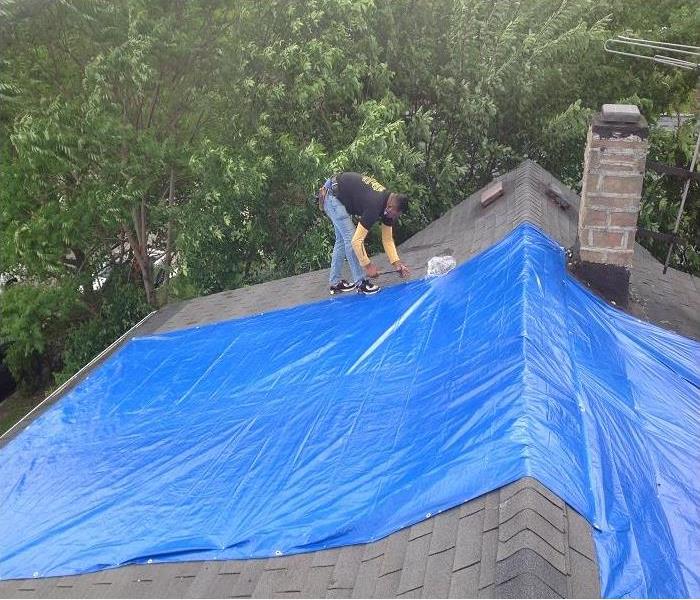 Putting a trap over where the storm damage is to protect inside the home.
Putting a trap over where the storm damage is to protect inside the home.
Even with forecasts, we know weather is not always 100% accurate and it can seem like severe storms will come out of nowhere. When storms blow through your town, they bring all sorts of conditions with them. Here are just a few of the basic types of damage a storm can cause to your home or business:
Wind
Storms bring strong gusts of wind that can harm your house in different ways. It can lift the shingles off your roof leaving it more exposed for further damage as the storm continues. Winds can also carry debris. When the debris comes in contact with your home at high speed, it can cause cracks and holes in siding or windows.
Water
Heavy rain fall can cause flooding in the streets as well as inside your home. Water can find its way into your home from the ground level or even a crack in the roof. Water damage that sits too long can pose threats to your home’s structural integrity and potential hazard issues with mold.
Hail
Damage done by hail is quite similar to when it is done by wind. The main difference is that hail melts away so the next day it might be difficult to identify the cause. Hail damage can cause cracks and holes in siding or knock away roofing materials. It is also common for hail to shatter or cause chips in a home’s windows.
Tornado Safety Information
7/28/2020 (Permalink)
 Tornado's are a scary event that it is best to be prepared for.
Tornado's are a scary event that it is best to be prepared for.
Here in the Midwest, we are no stranger to the weather conditions that spring and summer bring. From extreme heat waves to damage inducing thunderstorms, we have seen it all. At some point you may even be unlucky enough to experience the conditions perfect for creating a tornado. Whether you are at home or out and about, it is smart to know some information for tornado safety.
Watch vs. Warning
When you see an alert that says ‘Tornado Watch’ is means that the conditions outside are favorable for a tornado to happen. See it as you need to ‘watch’ the weather closely but one has not formed yet. A tornado warning means that one has been spotted or indicated on a weather radar as about to form and immediate action needs to take place. It is a ‘warning’ that one has formed and is close to you.
At Home
If you are under a tornado warning, it is best to get to the basement or storm cellar. If you don’t have one, get to an interior room in the house on the first floor. Make sure to stay away from any windows or doors as they could shatter and harm you. It is smart to have an emergency kit with water, flashlights, batteries, and first aid supplies available.
On the Road
While driving on the road and a tornado warning is happening, it is safest to not get under an overpass or bridge. You are safer in a flat location or ditch to lay low in. Flying debris can cause severe injury so use your arms to protect your neck and head.
Tornado's are dangerous and can cause serious injury or death, so if one is happening, take it seriously. If your home is affected by tornado or wind damage, call SERVPRO of Oak Park-River Forest at (708) 483-8636.
Hurricane Help
11/7/2018 (Permalink)
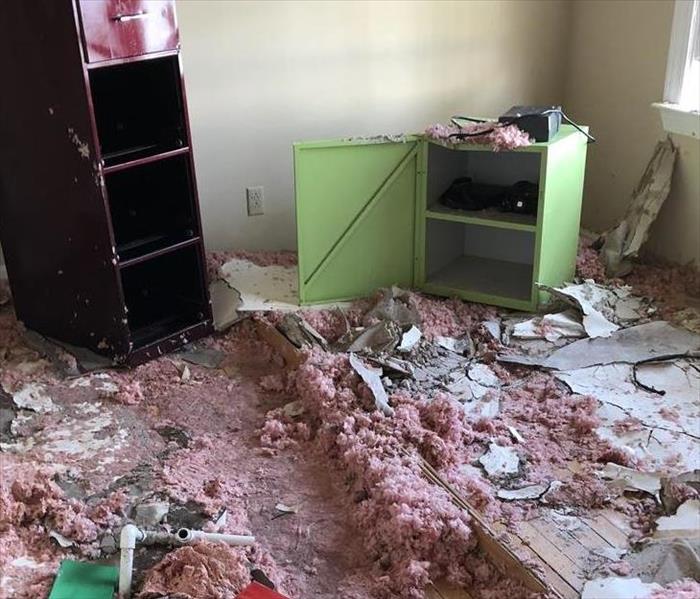 Hurricane destruction...SERVPRO is here to help...
Hurricane destruction...SERVPRO is here to help...
The Carolina's were hit with a massive hurricane in September, 2018. This picture shows the mess that was left in its wake.
SERVPRO of Oak Park-River Forest travelled to North Carolina to help the local franchises with all the destruction left in the hurricanes path. SERVPRO franchises stick together and help each other out in times of crisis.
Spring is Coming and SERVPRO is Ready
6/5/2018 (Permalink)
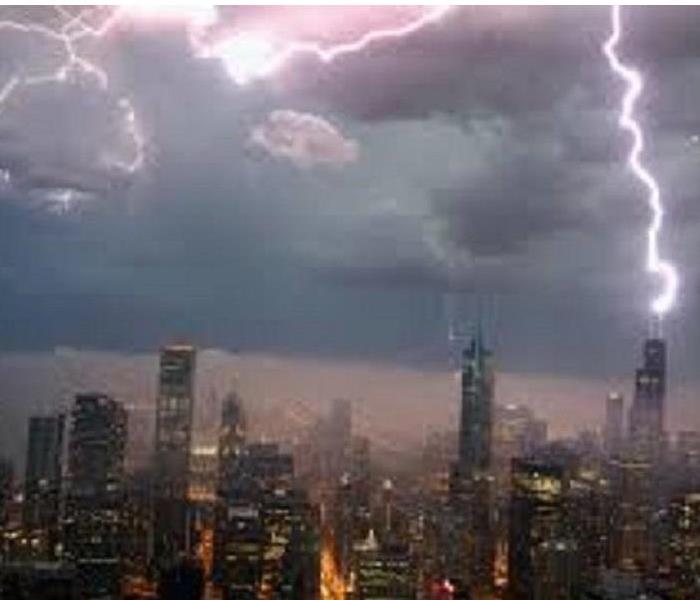 Storm hitting the Chicagoland area and surrounding suburbs.
Storm hitting the Chicagoland area and surrounding suburbs.
SERVPRO of Oak Park-River Forest specializes in storm and flood damage restoration. Our crews are highly trained and we use specialized equipment to restore your property to its pre-storm condition.
Faster Response
Since we are locally owned and operated, we are able to respond quicker with the right resources, which is extremely important. A fast response lessens the damage, limits further damage, and reduces the restoration cost.
Resources to Handle Floods and Storms
When storms hit the Oak Park-River Forest area, we can scale our resources to handle a large storm or flooding disaster. We can access equipment and personnel from a network of 1,650 Franchises across the country and elite Disaster Recovery Teams that are strategically located throughout the United States.
Have Storm or Flood Damage? Call Us Today 708-483-8636





 24/7 Emergency Service
24/7 Emergency Service



